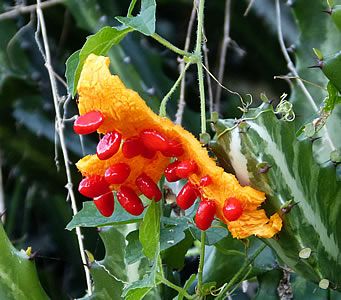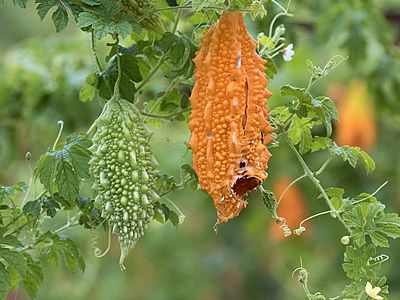Bitter Gourd (Momordica charantia) is a climbing, monoecious, fruit-bearing plant, originally from India and China, and is widely cultivated in various regions of the world. Herbaceous in texture, its flexible, pubescent, and branched stems attach to supports through curvilinear tendrils. The leaves are smooth, membranous, alternate, hairy, and deeply lobed, dividing into three to seven lobules.
It flowers in summer, with each plant bearing separate yellow, pentamerous male and female flowers. They emerge in the leaf axils, in simple, isolated inflorescences. Following pollination, the fruits develop, resembling cucumbers, oblong, and yellow or orange when ripe. They have a rough skin with soft spikes, opening into three valves, exposing seeds covered with a sweet red aril. The seeds are large and flat.

There are three different varieties of bitter gourd: a small one with bitter fruits, measuring 10 to 20 centimeters (4 to 8 inches) in length and weighing about 100 to 300 grams (3.5 to 10.5 ounces); the long Chinese type, light green in color, with few bumps, slightly bitter, 30 to 60 cm (12 to 24 inches) long and weighing 200 to 600 grams (7 to 21 ounces); and the triangular Indian type, strongly bitter, with triangular bumps, tapered ends, 9 to 12 cm (3.5 to 4.7 inches) long and weighing 300 to 600 grams (10.5 to 21 ounces).
The fruits of the bitter gourd are usually consumed while still green, as they are less bitter and have a milder flavor. They have a watery and crunchy flesh and can be used in a variety of culinary preparations, mainly in salads, pickles, stews, fried, sautéed, and soups. They are widely regarded as medicinal in different cultures (see box below the main text).

Its cultivation and management are simple, with cultural practices similar to those of domestic cucumbers. They are hardy and seldom affected by pests. For those who enjoy experimenting with exotic flavors, bitter gourd is an interesting option for home gardens. It can also be planted in pots and planters. However, it is important to provide support, preferably a trellis, for it to climb during its development.
It should be grown in full sun, in fertile soil, preferably sandy, enriched with organic matter, well-drained, and watered regularly. If the soil is well-prepared and manured before planting, additional fertilization is not necessary during the plant’s cycle.
It thrives in tropical heat but can withstand cold, with reduced productivity. It is propagated by seeds, sown in a seedbed or directly in the final location, protected from strong sun or winds. Germination occurs in 5 to 7 days. When the seedlings are about 20 days old, support can be offered for climbing.


